| |
|
 |

Rescue
From Land
If the wreck was close to shore, a line was shot out to
the vessel (lyle gun) and the survivors brought ashore in
a breeches buoy--think of it as a rescue by clothesline,
getting this equipment close to the wreck could be a problem.
A breeches buoy
was simply a pair of canvas pants sewed onto a life preserver.
|
The Wreck of the Raphaele
D.
The Raphaele D. went aground in 1896. Superintendent Bouteilliers
described the rescue in a report to his supervisor in Halifax:
The wreck was discovered and the
lifesaving crew alerted quickly. The crew had to haul a cart
carrying the line-throwing gun nearly 12 miles up the beach
on one side of the island, then across a shallow ford in the
Wallace Lake, then back down the beach on the other side of
the island.
When they finally arrived at the
wreck site, they found 5 men still on board "sitting in
the outside holding on by the mizzen chain plates". The
crew shot a line out to the ship and the survivors were safely
landed in the breeches buoy before dark. "The whole crew
all wet, some nearly naked, were sent to No. 2 and No.3 where
they were provided for during the night".
|
Lyle Gun
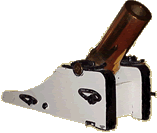
|
Lightweight
rope was shot out to the
wreck with the Lyle gun.
|
|
It was carefully wound on
a rope-board so it would uncoil without snagging. The
crews would then use this rope to haul out the heavier
lines which actually carried the breeches buoy.
|
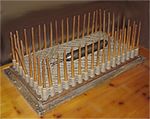
Rope board
|
The Lyle gun replaced the rocket
apparatus used on Sable before 1896. It could send a line out
to wrecks within 200 m. off shore.
Superintendent Bouteilliers
praised in 1897: "The Lyle gun has been tried and is preferred
before all the rest. It possess accuracy, simplicity, handiness
and cheapness".
Rescue at Sea
Lifeboat work called for discipline,
sound judgment and punishing physical effort. When possible, a
line was shot out to the vessel in distress to avoid battling
the dangerous surf in small boats.
The Wreck of the Barque Gerda
The Gerda went aground
on Sable in July 1890. Superintendent Bouteilliers described
the lifesaving crew's actions in his diary:
"We did not succeed to get
hawser on board on account of the tide and the fog being too
thick to clearly see what we were doing. At this juncture night
set in and we suspended operations."
Next day, "the surf was breaking
too heavy to launch a boat and the staff remained on the beach
through the night."
"At 3 am, got all hands and
hauled the Life Boat Grace Darling from the Lake to the
South Side and launched her....Broke steering iron and lost
steering oar getting off. Approached the wreck as nearly as
possible and on account of spars and rigging laying alongside,
the balance of crew on board were hauled off through the sea
with a heaving line. All landed safe and well at 5am (nearly
all hands lost their clothes)."
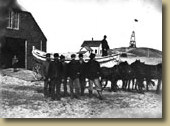
Lifesaving crew with the Beebe surfboat Reliance,
1895
Special Boats for a Special
Job
Beebe McLellan self-bailing
lifeboat, in use from 1892 and now on display at the Maritime
Museum of the Atlantic in Halifax, Nova Scotia.This type of
boat replaced metal lifeboats donated in 1854 by American humanitarian
Dorothea Dix.
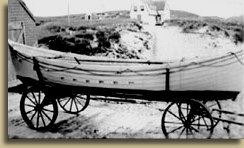
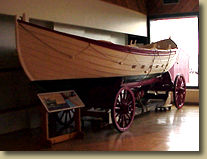
On display at the
Maritime Museum of the Atlantic.
Home
| Nature | History
| Sable Today | Fun
| About | Feedback
| Franšais
|









